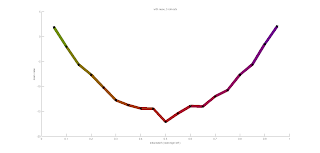Progress
- Environment overview:
- Light dark domain with a discrete state space (grid world)
- If a move would end outside of the grid, the agent enters the grid again on the opposite side (e.g., agent leaves on the left side and enters on the right side)
- Initial belief: uniform over all possible states (except for goal state)
- Current set-up (A=agent, G=goal, L=light):
***L*
**AL*
*G*L*
***L*
***L*
- Behavior of the agent:
- No tendency to go in a particular direction in the first step
- Belief update: There seems to be something incorrect with either taking the probability density function to update the belief or with the probability density function itself (it gives probabilities > 1 which is not correct)
- Implemented a visualization tool for the tree:
Progress
- Extended the incremental regression tree learner to multidimensional, continuous observations
- Implemented a discrete state space version of the light-dark environment:
- Agent A is placed in a grid world and has to reach a goal location G
- It is very dark in this grid world but there is a light source in one column, so the idea is that the agent has to move away from its goal to localize itself
- Actions: move up, down, left, right
- Observations: location(x,y) corrupted by some zero-mean Gaussian with a standard deviation given by the following quadratic equation:
STD = sqrt [ 0.5 * (x
best - x)^2 + K ]
- Rewards: -1 for moving, +10 for reaching the goal
- Finished the background chapter
Experimental set-up
- Environment: 5x10 light-dark domain, light source in column 9:
G*******L*
********L*
******A*L*
********L*
********L*
- Number of episodes: 1,000
- Max. steps: 25
- UCT-C: 10
- Discount factor: 0.95
- Optimal is the MDP-solution based on shortest distance from the agent's starting location to the goal location
Results
 |
| Normal Scaling |
 |
| X-Axis scaled to Log |
Planning
- Try a larger grid world (the agent does not show the behavior of going right for the first few steps and then left)
- Continue writing
- Meeting tomorrow at 13:00
Experimental Set-up
- One action performed in the real world, from different initial beliefs
- Probability(state = tiger left) = initial belief
- Number of episodes: 5,000
- Algorithms:
- Re-use computes the belief range for each leaf of the observation tree and only splits a leaf in the observation tree if the distance between the belief ranges that the two new children would have is below some (very low) threshold
- Deletion is the standard COMCTS algorithm
Legend
- Re-use is straight line
- Deletion is dotted line
- The color of each line segment (p1,p2) is the RGB-mixture of the average percentages of the selected actions at the points p1 and p2
- Black markers indicate the data points (i.e., the initial beliefs)
Results
Experimental Set-up
Results
Experimental Set-up
- One step in the real world from different initial beliefs
- Color is the average RGB-mixture of the percentages of the selected actions at the two end points of each line segment
- red: listen
- green: open left
- blue: open right
Results
Experimental Set-up
- Environment: Infinite Horizon Tiger Problem (stopped after 2 steps)
- Roll-outs: 500
- Standard deviation is of the Gaussian noise added to the observation signal
Results
Algorithm:
- computes for each leaf of the regression tree the corresponding range in the belief space
- re-uses leaves with a similar range
Results:
 |
| First 1,000 roll-outs |
















